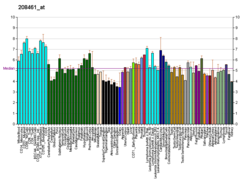HIC1
Protein-coding gene in the species Homo sapiens
| HIC1 | |||||||||||||||||||||||||||||||||||||||||||||||||||
|---|---|---|---|---|---|---|---|---|---|---|---|---|---|---|---|---|---|---|---|---|---|---|---|---|---|---|---|---|---|---|---|---|---|---|---|---|---|---|---|---|---|---|---|---|---|---|---|---|---|---|---|
| Identifiers | |||||||||||||||||||||||||||||||||||||||||||||||||||
| Aliases | HIC1, ZBTB29, ZNF901, hic-1, hypermethylated in cancer 1, HIC ZBTB transcriptional repressor 1 | ||||||||||||||||||||||||||||||||||||||||||||||||||
| External IDs | OMIM: 603825; MGI: 1338010; HomoloGene: 4740; GeneCards: HIC1; OMA:HIC1 - orthologs | ||||||||||||||||||||||||||||||||||||||||||||||||||
| |||||||||||||||||||||||||||||||||||||||||||||||||||
| |||||||||||||||||||||||||||||||||||||||||||||||||||
| |||||||||||||||||||||||||||||||||||||||||||||||||||
| |||||||||||||||||||||||||||||||||||||||||||||||||||
| |||||||||||||||||||||||||||||||||||||||||||||||||||
| Wikidata | |||||||||||||||||||||||||||||||||||||||||||||||||||
| |||||||||||||||||||||||||||||||||||||||||||||||||||
Hypermethylated in cancer 1 protein is a protein that in humans is encoded by the HIC1 gene.[5]
References
- ^ a b c GRCh38: Ensembl release 89: ENSG00000177374 – Ensembl, May 2017
- ^ a b c GRCm38: Ensembl release 89: ENSMUSG00000043099 – Ensembl, May 2017
- ^ "Human PubMed Reference:". National Center for Biotechnology Information, U.S. National Library of Medicine.
- ^ "Mouse PubMed Reference:". National Center for Biotechnology Information, U.S. National Library of Medicine.
- ^ "Entrez Gene: HIC1 hypermethylated in cancer 1".
Further reading
- Chopin V, Leprince D (2006). "[Chromosome arm 17p13.3: could HIC1 be the one ?]". Med Sci (Paris). 22 (1): 54–61. doi:10.1051/medsci/200622154. PMID 16386221.
- Wales MM, Biel MA, el Deiry W, et al. (1995). "p53 activates expression of HIC-1, a new candidate tumour suppressor gene on 17p13.3". Nat. Med. 1 (6): 570–7. doi:10.1038/nm0695-570. PMID 7585125. S2CID 21993943.
- Fujii H, Biel MA, Zhou W, et al. (1998). "Methylation of the HIC-1 candidate tumor suppressor gene in human breast cancer". Oncogene. 16 (16): 2159–64. doi:10.1038/sj.onc.1201976. PMID 9572497.
- Deltour S, Guerardel C, Stehelin D, Leprince D (1999). "The carboxy-terminal end of the candidate tumor suppressor gene HIC-1 is phylogenetically conserved". Biochim. Biophys. Acta. 1443 (1–2): 230–2. doi:10.1016/s0167-4781(98)00219-x. PMID 9838134.
- Deltour S, Guerardel C, Leprince D (2000). "Recruitment of SMRT/N-CoR-mSin3A-HDAC-repressing complexes is not a general mechanism for BTB/POZ transcriptional repressors: the case of HIC-1 and gammaFBP-B". Proc. Natl. Acad. Sci. U.S.A. 96 (26): 14831–6. Bibcode:1999PNAS...9614831D. doi:10.1073/pnas.96.26.14831. PMC 24733. PMID 10611298.
- Guerardel C, Deltour S, Pinte S, et al. (2001). "Identification in the human candidate tumor suppressor gene HIC-1 of a new major alternative TATA-less promoter positively regulated by p53". J. Biol. Chem. 276 (5): 3078–89. doi:10.1074/jbc.M008690200. PMID 11073960.
- Deltour S, Pinte S, Guérardel C, Leprince D (2001). "Characterization of HRG22, a human homologue of the putative tumor suppressor gene HIC1". Biochem. Biophys. Res. Commun. 287 (2): 427–34. doi:10.1006/bbrc.2001.5624. PMID 11554746.
- Deltour S, Pinte S, Guerardel C, et al. (2002). "The human candidate tumor suppressor gene HIC1 recruits CtBP through a degenerate GLDLSKK motif". Mol. Cell. Biol. 22 (13): 4890–901. doi:10.1128/MCB.22.13.4890-4901.2002. PMC 133903. PMID 12052894.
- Strausberg RL, Feingold EA, Grouse LH, et al. (2003). "Generation and initial analysis of more than 15,000 full-length human and mouse cDNA sequences". Proc. Natl. Acad. Sci. U.S.A. 99 (26): 16899–903. Bibcode:2002PNAS...9916899M. doi:10.1073/pnas.242603899. PMC 139241. PMID 12477932.
- Cardoso C, Leventer RJ, Ward HL, et al. (2003). "Refinement of a 400-kb critical region allows genotypic differentiation between isolated lissencephaly, Miller-Dieker syndrome, and other phenotypes secondary to deletions of 17p13.3". Am. J. Hum. Genet. 72 (4): 918–30. doi:10.1086/374320. PMC 1180354. PMID 12621583.
- Rathi A, Virmani AK, Harada K, et al. (2004). "Aberrant methylation of the HIC1 promoter is a frequent event in specific pediatric neoplasms". Clin. Cancer Res. 9 (10 Pt 1): 3674–8. PMID 14506157.
- Waha A, Waha A, Koch A, et al. (2004). "Epigenetic silencing of the HIC-1 gene in human medulloblastomas". J. Neuropathol. Exp. Neurol. 62 (11): 1192–201. doi:10.1093/jnen/62.11.1192. PMID 14656076.
- Lindsey JC, Lusher ME, Anderton JA, et al. (2004). "Identification of tumour-specific epigenetic events in medulloblastoma development by hypermethylation profiling". Carcinogenesis. 25 (5): 661–8. doi:10.1093/carcin/bgh055. PMID 14688019.
- Pinte S, Guérardel C, Deltour-Balerdi S, et al. (2004). "Identification of a second G-C-rich promoter conserved in the human, murine and rat tumor suppressor genes HIC1". Oncogene. 23 (22): 4023–31. doi:10.1038/sj.onc.1207504. PMID 15007385.
- Pinte S, Stankovic-Valentin N, Deltour S, et al. (2004). "The tumor suppressor gene HIC1 (hypermethylated in cancer 1) is a sequence-specific transcriptional repressor: definition of its consensus binding sequence and analysis of its DNA binding and repressive properties". J. Biol. Chem. 279 (37): 38313–24. doi:10.1074/jbc.M401610200. PMID 15231840.
- Chen W, Cooper TK, Zahnow CA, et al. (2004). "Epigenetic and genetic loss of Hic1 function accentuates the role of p53 in tumorigenesis". Cancer Cell. 6 (4): 387–98. doi:10.1016/j.ccr.2004.08.030. PMID 15488761.
- Britschgi C, Rizzi M, Grob TJ, et al. (2006). "Identification of the p53 family-responsive element in the promoter region of the tumor suppressor gene hypermethylated in cancer 1". Oncogene. 25 (14): 2030–9. doi:10.1038/sj.onc.1209240. PMID 16301995. S2CID 27624320.
- Valenta T, Lukas J, Doubravska L, et al. (2006). "HIC1 attenuates Wnt signaling by recruitment of TCF-4 and beta-catenin to the nuclear bodies". EMBO J. 25 (11): 2326–37. doi:10.1038/sj.emboj.7601147. PMC 1478201. PMID 16724116.
- Stankovic-Valentin N, Verger A, Deltour-Balerdi S, et al. (2006). "A L225A substitution in the human tumour suppressor HIC1 abolishes its interaction with the corepressor CtBP". FEBS J. 273 (13): 2879–90. doi:10.1111/j.1742-4658.2006.05301.x. PMID 16762039. S2CID 34249691.
External links
- HIC1+protein,+human at the U.S. National Library of Medicine Medical Subject Headings (MeSH)
This article incorporates text from the United States National Library of Medicine, which is in the public domain.
- v
- t
- e
(1) Basic domains | |||||||||||||||||||||||||
|---|---|---|---|---|---|---|---|---|---|---|---|---|---|---|---|---|---|---|---|---|---|---|---|---|---|
| |||||||||||||||||||||||||
(2) Zinc finger DNA-binding domains | |||||||||||||||||||||||||||
|---|---|---|---|---|---|---|---|---|---|---|---|---|---|---|---|---|---|---|---|---|---|---|---|---|---|---|---|
| |||||||||||||||||||||||||||
(3) Helix-turn-helix domains | |||||||||||||||||||||
|---|---|---|---|---|---|---|---|---|---|---|---|---|---|---|---|---|---|---|---|---|---|
| |||||||||||||||||||||
(4) β-Scaffold factors with minor groove contacts | |||||||||||||||||||
|---|---|---|---|---|---|---|---|---|---|---|---|---|---|---|---|---|---|---|---|
| |||||||||||||||||||
(0) Other transcription factors | |||||||||
|---|---|---|---|---|---|---|---|---|---|
| |||||||||
see also transcription factor/coregulator deficiencies
 | This article on a gene on human chromosome 17 is a stub. You can help Wikipedia by expanding it. |
- v
- t
- e


















